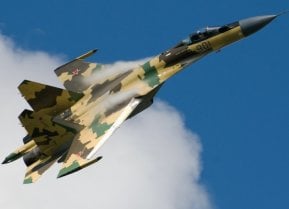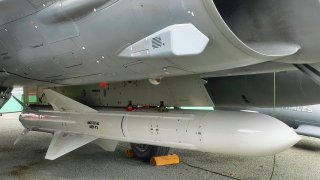Excocet: The French 'Flying Fish' Missile That Sank a Royal Navy Destroyer
It was over 40 years ago that a French-made fighter aircraft carrying a French-made Exocet anti-ship missile resulted in the greatest loss of a Royal Navy warship since the Second World War.
It was over 40 years ago that a French-made fighter aircraft carrying a French-made anti-ship missile resulted in the greatest loss of a Royal Navy warship since the Second World War.
During the Falklands War, an Argentine Super Étendard strike fighter successfully launched an aptly-named AM39 Exocet (French for "Flying Fish") missile – which struck the Type 42 guided missile destroyer HMS Sheffield on May 4, 1982.
While it has been disputed whether the missile actually exploded on impact with the warship, the strike still heavily damaged the destroyer, which soon caught fire. Twenty sailors were killed in the attack, while the rest of the crew was safely evacuated.
HMS Sheffield foundered while under tow on May 10.
The anti-ship missiles scored another victory on May 25 but didn't actually hit their intended target. A Royal Navy frigate was targeted, but its countermeasures resulted in the Exocet re-targeting and striking the 15,000-ton merchant ship Atlantic Conveyor. Finally, on May 30, two Argentine Super Étendard strike fighters attempted an attack with the last remaining air-launched Exocet in Argentina's arsenal against the Royal Navy aircraft carrier HMS Invincible.
However, the British defenses prevented the fighters from closing in on the carrier, and the Exocet was reportedly destroyed in flight. Despite that fact, the French-made missile still proved itself a capable weapon that could successfully take out a modern warship.
Meet the Exocet
Originally developed in the late 1960s, the MM38 Exocet first entered service in 1975. It was a sea-launched anti-ship missile that was designed to "skim" just two meters above the surface of the water to avoid radar detection while approaching the speed of sound to a distance of some 43 miles. It relied on an inertial guidance system for most of its trajectory, before it activated its onboard active guidance radar at the terminal stage.
As a result, the missile is only likely to be detected less than four miles away, giving air-defense systems less than half a minute to react before impact.
Seeing the success of the ship-launched version, development began in 1974 on the AM39, an air-launched version. This airborne variant of the Exocet family could be launched from fighter aircraft, maritime patrol planes, and even helicopters. The French-built Super Étendard could carry one 1,480-pound Exocet under one wing, with a fuel tank on the other for balance.
As with the ship-launched version, the AM39 limited the reaction time from air-defense systems. That was certainly the case with HMS Sheffield, whose crew had just 10 seconds to react.
Continued Upgrades of the Exocet
Development of an improved version of the MM38, designated the MM40, began in 1976, while further upgrades were made, which resulted in the development and employment of the AM39/MM40 Block 2 in 1992. A submarine-launched variant of the AM39, the SM39, began development in 1979 and it entered service in 1984. Coastal defense versions of the MM38/MM40 resulted in the introduction of the BC38/BC40, which can be employed on helicopters, destroyers, and frigates.
The MM40 Block 3 missile began development in 2004, and it was first tested via ship launch in 2010. Today, all of the Exocet missiles, except the original MM38 remain in production.
About the Author
Peter Suciu is a Michigan-based writer who has contributed to more than four dozen magazines, newspapers and websites. He regularly writes about military hardware, and is the author of several books on military headgear including A Gallery of Military Headdress, which is available on Amazon.com. Peter is also a Contributing Writer for Forbes.
Image Credit: Creative Commons.


